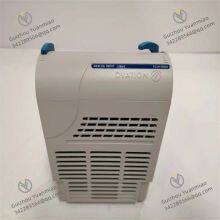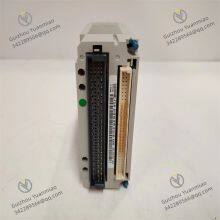Material
Other, Global universal model
Condition
Other, Global universal model
Task
Other, Global universal model
Mathematical Model
Other, Global universal model
Signal
Other, Global universal model
Customized
Non-Customized
Structure
Other, Global universal model
Power Supply
24VDC
Operating temperature
-40℃ to 70℃
Dimensions
19 x 8.5 x 6.3cm
I. Overview
EMERSON 1C31113G01 is an important digital input module in the DeltaV distributed control system, playing a key role in the field of industrial automation control. It is mainly responsible for collecting digital signals from industrial sites, such as the start-stop status of equipment, limit switch signals, alarm signals, etc., and accurately transmitting these signals to the central processing unit of the control system, providing basic data support for the system's logical judgment and control decisions.
Relying on Emerson's advanced technology and strict production standards in the industrial control field, this module features high reliability and strong anti-interference ability. It can adapt to complex environments of industrial sites in chemical, petroleum, electric power and other industries, ensuring the accuracy and stability of digital signal collection, and is an important component to ensure the safe and efficient operation of industrial production processes.

II. Technical Parameters
Input Channels: It has 16 independent digital input channels, each of which can independently collect digital signals. It can process status signals of multiple on-site devices at the same time, meeting the signal collection needs of medium and large-scale industrial control scenarios.
Input Signal Types: It supports two input modes: dry contact and wet contact. Dry contact input does not require an external power supply and is suitable for connecting mechanical contact devices; wet contact input requires an external DC power supply (usually 24VDC) and can be adapted to various electronic switch signals.
Input Voltage Range: For wet contact input, it usually supports a voltage range of 24VDC (±10%), which can adapt to slight fluctuations of power supply voltage in industrial sites and ensure the stability of signal collection.
Response Time: The response time of the input signal is short, generally within 1ms, which can quickly capture the status changes of on-site equipment and ensure the real-time monitoring of equipment status by the control system.
Isolation Performance: Optoelectronic isolation technology is adopted between each input channel and between the channels and the internal circuit of the module. The isolation voltage can usually reach 2500V AC, which effectively prevents signal interference between channels and improves the anti-interference ability and working reliability of the module.
Working Environment: The operating temperature range is 0-60℃, which can work stably in the conventional temperature environment of industrial sites; the relative humidity is 5%-95% (no condensation), with a certain moisture-proof ability; it can withstand a certain degree of vibration and impact, meeting the environmental adaptability requirements of industrial equipment.
Power Requirements: It adopts DC power supply, with a typical working voltage of 24VDC and low power consumption. The power consumption in normal working state is usually within a few watts, which will not bring too much burden to the system power supply.

III. Functional Features
Multi-channel Signal Parallel Collection: The 16 independent input channels can collect digital signals of multiple on-site devices at the same time without waiting or polling, which greatly improves the efficiency of signal collection and ensures that the control system can timely obtain comprehensive status information of on-site devices.
Strong Anti-interference Ability: Through various means such as optoelectronic isolation, reasonable circuit layout and shielding design, the module has excellent anti-electromagnetic interference ability. It can accurately identify and collect digital signals in complex electromagnetic environments with strong electromagnetic radiation and motor start-stop interference in industrial sites, avoiding signal misjudgment caused by interference.
Diagnosis and Alarm Function: It has channel-level diagnosis function, which can monitor the working status of each input channel in real time. When a channel has disconnection, short circuit or signal abnormality, the module will send out a fault alarm signal in time and upload the fault information to the control system, facilitating maintenance personnel to quickly locate and troubleshoot faults, and reducing system fault handling time.
Convenient Installation and Maintenance: It adopts a standard rail-mounted installation method, which makes the installation process simple and fast, and is convenient for layout and fixing in industrial control cabinets. The terminal blocks of the module adopt spring-type or screw-fixed design, which makes the wiring firm and easy to disassemble, facilitating later maintenance and line inspection.
Strong Compatibility: As a standard module of the DeltaV distributed control system, it can be seamlessly compatible with other modules in the system (such as digital output modules, analog modules, etc.) and the central processing unit. It can be integrated with the system without complex configuration, reducing the difficulty and cost of system construction.

IV. Common Faults and Solutions
No Input Signal in Channels
Fault Phenomenon: One or more input channels cannot collect signals from on-site equipment, and the control system shows that the channel status is "disconnected" or "invalid".
Possible Causes: The connecting line between the on-site equipment and the module is broken or has poor contact; the on-site equipment is faulty and does not output effective signals; the corresponding input channel of the module is damaged; the external power supply fails during wet contact input.
Solutions: First, check the connecting line, check whether the cable is damaged or broken, re-plug the terminal block to ensure good contact. Detect whether the on-site equipment works normally, which can be tested by short-circuiting the equipment contacts or replacing the equipment. For wet contact input, check whether the external power supply is normal and whether the voltage is within the specified range. If all the above checks are normal, the input channel of the module may be damaged, and the module needs to be replaced or professional maintenance personnel should be contacted for repair.
False Signal or Interference
Fault Phenomenon: The signal collected by the input channel is inconsistent with the actual status of the on-site equipment, and there are false "on" or "off" signals, leading to misjudgment by the control system.
Possible Causes: There is strong electromagnetic interference in the industrial site, affecting signal transmission; the shielding measures of the input channel are not in place; the module is poorly grounded; the power supply voltage fluctuates too much.
Solutions: Check the grounding of the module to ensure that the grounding resistance meets the requirements (usually less than 4Ω). Good grounding can effectively suppress electromagnetic interference. Take shielding measures for the signal transmission line, use shielded cables and ground the shielding layer at one end. Keep away from strong electromagnetic interference sources (such as large motors, transformers, etc.), or add shielding baffles between the module and the interference source. Check the power supply voltage to ensure that the voltage is stable within the specified range. If necessary, equip the module with a regulated power supply.
Module Communication Fault
Fault Phenomenon: The module cannot communicate with the central processing unit of the DeltaV control system, and the system shows that the module is offline or has a communication error.
Possible Causes: The connecting line between the module and the system bus is loose or broken; the communication interface of the module is damaged; the address setting of the module is wrong or conflicts with other modules; the system bus is faulty.
Solutions: Check the connecting line between the module and the system bus, re-plug the connector to ensure a firm connection, and check whether the line is damaged. Check the address setting of the module to ensure that the address is unique and consistent with the system configuration to avoid address conflict. Replace the module to other bus interfaces for testing. If communication is restored, the original communication interface may be faulty; if the problem persists, try to replace the module. If communication is normal after replacement, it indicates that the original module has a hardware fault and needs to be repaired or replaced. At the same time, check whether the system bus works normally, which can be judged by testing the communication status of other modules.














































